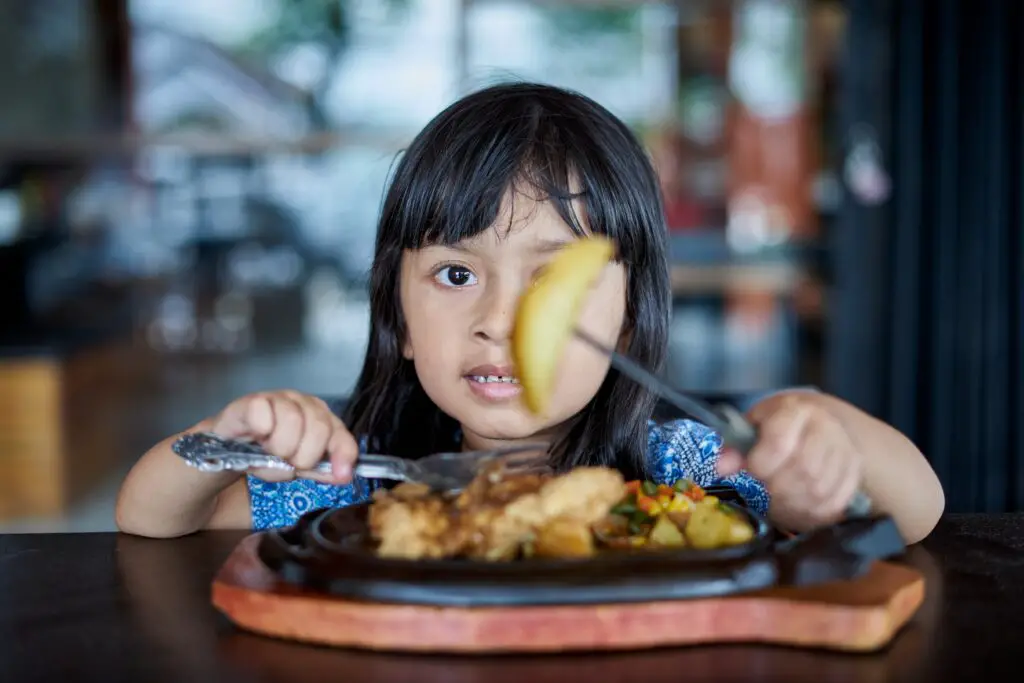1. No Talking with Your Mouth Full

One of the most well-known rules that many of us were taught in school is the importance of keeping your mouth closed while chewing. This wasn’t just about manners—it was considered a sign of respect for those around you. The idea was that a full mouth made you appear unrefined, and the sound of chomping could be off-putting. While it may seem like common sense now, back in the day, schools would go as far as to offer lessons on chewing with your mouth closed, aiming to instill proper etiquette from an early age.
Beyond simple politeness, there was an underlying belief that talking while eating could cause digestive issues. The logic followed that speaking and chewing at the same time led to air swallowing, potentially causing discomfort or indigestion. Schools believed this rule helped kids not only develop manners but also promote better eating habits. So, next time you’re at the dinner table, remember: it’s not just about being polite—it’s about keeping your digestive system happy!
2. Chew 32 Times Before Swallowing

This rule is one that probably left a lot of kids scratching their heads. The idea of chewing each bite 32 times seemed excessive, but it was a strict guideline in many school nutrition programs. Teachers would often remind students that the more thoroughly you chewed, the easier it would be for your stomach to digest food. The number 32 was more symbolic than practical—an ideal that helped reinforce the idea of eating slowly and mindfully.
While modern nutritionists may not insist on a specific number of chews, the spirit of the rule remains relevant. Properly chewing food allows the body to break down nutrients more efficiently, aiding digestion and promoting satiety. Though it’s likely you won’t count each bite, the practice of chewing slowly still carries weight in today’s healthy eating habits, reminding us to savor our meals and take our time.
3. Always Sit Up Straight While Eating

Good posture during meals was another fundamental rule taught in schools. Straightening up your back and sitting with your feet flat on the floor wasn’t just about looking dignified; it was believed to improve digestion and promote healthier eating habits. In fact, many teachers would insist that students maintain proper posture as a way to show respect for the food they were eating.
It turns out that this rule wasn’t entirely based on aesthetics. Sitting up straight can indeed help with digestion by allowing the stomach to expand properly and reduce pressure on the abdomen. So, while it may have seemed like a minor instruction, maintaining good posture during meals could actually aid in better nutrient absorption, a reminder that how you sit is just as important as what you eat.
4. No Snacking Between Meals

Snacking between meals was once viewed as an unacceptable habit, especially in school settings. Children were taught to eat three balanced meals a day and avoid any food in between. This idea was based on the belief that regular, unplanned snacking would upset the body’s natural digestive cycle and lead to unhealthy eating patterns. Schools would even provide snacks at designated times, emphasizing the importance of structure.
Today, we know that snacking, when done correctly, can be part of a healthy diet. However, the original rule taught a valuable lesson about being mindful of food timing. By spacing meals out properly, kids were encouraged to pay attention to their hunger cues and avoid mindless grazing. While the rule may have been restrictive, it helped establish the foundation for understanding the importance of moderation.
5. Never Leave the Table Until Everyone Is Done

This rule may seem old-fashioned, but it was once common practice in schools to encourage children to wait until the entire group had finished eating before leaving the table. This principle was rooted in fostering a sense of community and politeness during mealtimes. Teachers emphasized that meals were a time for social interaction, and leaving the table prematurely could be seen as rude or inconsiderate.
In a modern context, the emphasis on communal dining has only grown in popularity. Eating together is now known to build stronger family connections and improve overall well-being. While the specific rule of waiting until everyone is done may not always apply today, the lesson about sharing mealtime experiences remains as relevant as ever.
6. Don’t Reach Across the Table

It was once considered impolite to reach across the table to grab something without first asking. Schools taught students that doing so disrupted the flow of conversation and made the meal feel chaotic. Instead, students were encouraged to wait for the item to be passed to them or to ask politely for it. The idea was to maintain decorum at the table, ensuring everyone had equal access to the food without appearing greedy or rude.
Though this rule may not be as strictly enforced today, its emphasis on respect for others during meals still holds up. Asking for something to be passed—whether it’s the salt shaker or a dish of mashed potatoes—remains a polite way to interact at the table. This rule helped instill the importance of patience, showing that a meal was about more than just food—it was about being present and considerate.
7. Don’t Talk About How Much You Hate a Dish

In many schools, it was considered impolite to openly criticize the food placed before you. While it’s not uncommon to dislike certain dishes, children were taught that voicing complaints about food was disrespectful, especially if someone else had gone through the effort of preparing it. This rule was part of a larger set of dining expectations that aimed to create an environment where all foods were appreciated, even if they weren’t favorites.
As an adult, the rule might seem a bit restrictive, but there’s wisdom in showing gratitude for what’s on your plate. This lesson extended beyond the classroom and into real-life etiquette—making sure to express thanks for food, even if you didn’t love it. In a way, it encouraged a mindset of gratitude, focusing on the positives rather than the negatives when it came to dining experiences.
8. Don’t Play with Your Food

Finally, the infamous “don’t play with your food” rule was drilled into us from a young age. Teachers emphasized that food was meant to be consumed, not used as a toy or a means of creative expression. Whether it was making shapes out of mashed potatoes or using peas to create a mini sculpture, playing with food was seen as a sign of poor manners and a lack of respect for the meal.
While we’ve certainly loosened up in terms of creative cooking today, there’s still something to be said for this rule. Focusing on the food itself, rather than turning it into a distraction, helps keep the dining experience more meaningful. In a world full of distractions, enjoying food for what it is—without making it into a game—might just be the best way to appreciate what’s on your plate.
